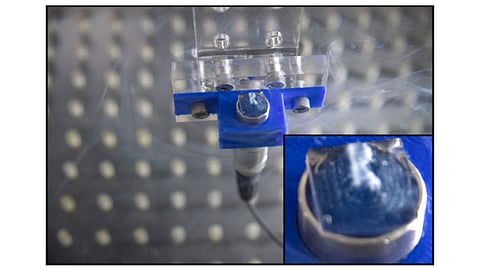"We've used these vesicles for imaging previously, and this time we've shown that we can actually use them as actuators so we can apply force to these objects using ultrasound," says Di Wu (MS '16, PhD '21), a research scientist in Shapiro's lab and the study's lead author. "What this allows us to do is to move cells around in space using ultrasound and to be able to do so in a very selective manner."
Shapiro and Wu say there a few reasons you might want to be able to move cells around. For one, tissue engineering—the creation of artificial tissues for research or medical purposes—requires cells of specific types to be arranged in complex patterns. An artificial muscle might need multiple layers of muscle cells, cells that create tendons, and nerve cells, for example.
Another case in which you might want to move cells around is in cell-based therapy, a field of medicine in which cells with desirable properties are introduced into the body.
"You're introducing engineered cells into the body, and they go all over the place to find their target," Di says. "But with this technology, we potentially have a way to guide them to the desired location into the body."
As a demonstration, the team showed that cells containing gas vesicles can be forced to clump into a small ball, or arranged as thin bands, or pushed to the edges of a container. When they changed the ultrasound pattern, the cells "danced" to take up new positions. They also developed an ultrasound pattern that pushed the cells into the shape of the letter "R" in a gel that held them in that shape after it solidified. They call the resulting figure an "acoustic hologram."
Wu says one area where their research has the potential for immediate impact is in cell sorting, a process necessary for various kinds of biological and medical research.
"A common way people sort cells now is to engineer them to express a fluorescent protein and then use a fluorescent-activated cell sorter (FACS)," he says. "That is a $300,000 piece of equipment that is bulky, often lives in a biosafety cabinet, and doesn't sort cells very fast."
"In contrast, acousto-fluidic sorting can be done with a tiny little chip that costs maybe $10. The reason for this difference is that in fluorescent sorting, you have to separately measure the gene expression of the cells and then move them. This is done one cell at a time. With gas vesicle expression, the cell's genetics are directly linked to the force that's being applied to the cell. If they express gas vesicles, they will experience a different force, so we don't need to separately check if they're expressing gas vesicles and then move them; we can move them all at once. That greatly simplifies things." (MSM/Newswise)
Hurry up! Join the Medical Internship 3.0 at MedBound!


